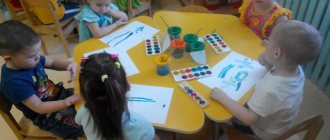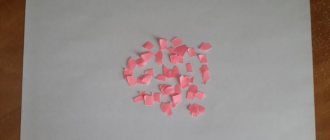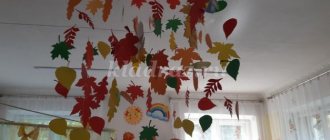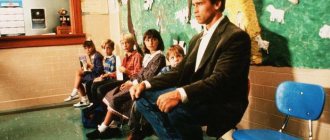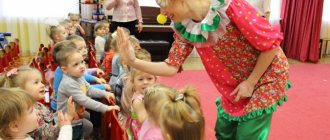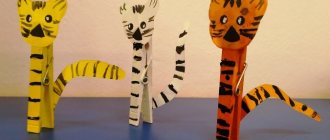Summary of an autumn walk in the junior group of kindergarten
Autumn walk in the junior group of kindergarten
Author: Krivenkova Irina Leonidovna Place of work: teacher at MBDOU d/s No. 296 Samara
Autumn walk in the younger group of kindergarten “Wind Observation”
Purpose: I bring to your attention a summary of the autumn walk in kindergarten “Wind Observation”. This work will be useful for teachers of the younger group. This is a summary of the cognitive development of children, during which children become familiar with such a natural phenomenon as wind. Goal: consolidate knowledge about wind Tasks: consolidate the concepts of “strong wind”, “windy weather”, “weather vane”; development of sound culture of speech; develop children's interests, their curiosity and cognitive motivation; form primary ideas about objects of the surrounding world; fixing primary colors; contribute to the acquisition of experience in children’s motor activity, facilitate the implementation of basic types of movements (walking, running). Equipment: children's weather vanes (according to the number of children); bubble; take-out material. Progress of the walk: The children went for a walk to the group’s area with weather vanes in their hands. The teacher draws the children's attention to the fact that the weather vanes began to move and clarifies that they were static in the room. Asks children to explain this phenomenon. If children, help them with the answer. Offers to listen to a poem about the wind. I saw how the breeze flew towards us! He quietly pushed the window open, played with my Panama hat, fiddled around and fell asleep. G. Lagzdyn Educator: It’s windy outside today. Let's check how strong the wind is. Take the weather vane, raise it higher, look at it. The weather vane moves quickly in the wind, which means a strong wind is blowing. What wind is blowing? Children: Strong wind Teacher: when there is no wind, the weather vane does not sway. Look at the trees, why do they sway? Children: The wind is blowing. Strong wind... Educator: When the wind blows strongly, the trees begin to sway, the branches bend, the leaves rustle. Let's listen to the rustling of the leaves on the trees: sh-sh-sh-sh. Let's imagine that we are leaves and try to talk just like them. Children: (loudly) Sh-sh-sh-sh. Educator: Guys, look carefully, the wind has calmed down now. The trees no longer sway, and the leaves rustle very quietly. And now it’s your turn to move quietly. Children: (quietly) Sh-sh-sh-sh. Educator: The wind can be not only cold and prickly, like in winter, but also warm. Let's raise our hands and try to find out what kind of wind it is now - warm or cold. Children: Cold, my hands are cold. Educator: Now I will blow soap bubbles, and you and I will determine which direction the wind is blowing. In which direction the bubbles fly, the wind blows there. Show with your fingers where the bubbles went. Children play with soap bubbles. Educator: Look, a strong wind blew. Let's listen to the sound: ooo-oo-oo-oo. Let's blow hard and loud and sway like trees. We will inhale through our nose and exhale through our mouth with the sound ooo-oo-oo-oo. Raise your arms up like tree branches and swing them (the exercise is repeated several times, you can say it loudly or quietly, or swing in accordance with the sound). Individual instructions for several children - to distribute shovels to all children for the didactic game “The Wind Is Blowing” (tossing fallen leaves with a spatula in the direction and against the wind). After the didactic game, children begin independent play activities. Work assignments: collecting take-out material in the basket. Organized entry into the group.
We recommend watching:
Autumn holiday in the younger group. Scenario Summary of an autumn walk in the senior group Environmental education of preschool children in the fall Summary of an autumn ecological walk in the preparatory group of a kindergarten
Similar articles:
Summary of the excursion in the younger group in the fall
Walks in the fall in the junior group of kindergarten. Notes
Outdoor games for a walk in the younger group in the fall
Observations on a walk junior group
SEPTEMBERWalk 1 Observing seasonal changes in nature
Goals:
- form ideas about changes in nature (the day has become shorter, the night has become longer);
- learn to distinguish and characterize the signs of early autumn, recognize them in poems; - cultivate a love for nature. Progress of observation
Summer has passed, Autumn has arrived. The fields and groves are empty and sad. The birds have flown away, the days have become shorter. The sun is not visible, the nights are dark and dark.
The teacher asks the children riddles.
• Gold coins are hanging on a branch. (Autumn leaves.) • On the ceiling, in the corner, there is a sieve hanging - not twisted by hand. (Cobweb.) • Without hands, but the canvas weaves. (Spider.)
The teacher tells the children about signs.
September
- dawn, gloomy;
cold-weather and cold-father September, but it is a lot to feed, they call it “autumn singer” and “golden flower”; grasses in meadows, fields, and forests dry out, turn yellow, and the foliage of trees and shrubs turns golden. September
is the first autumn month. At the beginning of the month there are still warm, sunny days. The sky sparkles blue, the leaves of maples and birches show through with golden patterns. The air is clean, transparent, silver threads of the web fly. Such days are called “Indian summer”.
The teacher asks the children questions.
• Why is September called “golden flower”?
• What days of September are called “Indian summer”? • What are the signs of “Indian summer”? Labor activity:
Cleaning up waste on site. Goal: to cultivate a desire to work.
Outdoor games
"Geese", "Shepherd and Flock".
Goals:
- improve coordination of movements; - develop dexterity and spatial orientation.
Individual work
"Catch the ball."
Goal:
develop dexterity.
Independent games with external material.
Walk 2 Observation of the flower garden
Target:
to form children's ideas that flowers are alive, they grow and change.
Progress of observation
The plants in the flowerbed grew well, bloomed while it was warm, there was a lot of light and water; now the days are becoming short, there is a lot of water, but little heat, the flowers are fading, and in their place seeds are formed, from which new plants can appear.
Autumn has come, the flowers have dried up. And the bare bushes look sad.
The teacher asks the children questions.
• What did the flowers in the flowerbed look like? • Why did they wilt? • What needs to be done to make the flowers grow again in the spring? (Collect seeds.)
Labor activity
Collecting flowers in boxes. Purpose: to learn to distinguish mature seeds from immature ones.
Outdoor games
"Ducklings", "Birds and Rain".
Goals:
- exercise in running, climbing, jumping; - Develop agility and speed.
Outdoor games
“Throw it - catch it”, “Find where it’s hidden”
Goals:
- practice throwing and catching the ball - teach orientation in space.
Individual work
"Gather your toys."
Goal:
develop Attentiveness.
Walk 3 Crow Watching
.
Goals:
— expand knowledge about the crow;
- cultivate curiosity and interest in the life of birds. Progress of observation The teacher asks the children questions.
• What does a crow look like? • What does she eat? • Is this bird a wintering or migratory bird? • How does a crow scream?
Crow
- a large bird. The crow's head, beak, throat, wings, tail and paws are black, and everything else is gray. The crow is a cunning, dexterous and resourceful bird. It winters and lives next to humans; the crow usually sits on garbage containers and landfills where there is always something to eat, because the crow is an omnivorous bird. She shouts “kar-kar”.
The lame old crow has been living in my garden for a long time. She built her house in the thick green branches of a maple tree.
Labor activity
Collection of flower seeds.
Goal
: develop the desire to do work together.
Movable IPs
“Bird and cat”, “Colored cars>.
Goal:
to learn to move in all directions without bumping into each other.
Individual work
Development of movements.
Goal:
to consolidate the ability to jump on one leg (right and left).
Walk 4 Weather observation
Target:
consolidate knowledge about seasonal changes in plant life.
Progress of observation:
The teacher asks the children questions. What time of year is it now? How did you guess? Do you know where we will go now? What grows in the garden? How can you call all this in one word? How many of you know riddles about vegetables? Where do vegetables grow? Each group of vegetables grows in its own bed. In the fall, gardeners harvest vegetables and then preserve them. Vegetables grow on the ground and in the ground. Today we will collect vegetables and take them to the kitchen so that the cook can prepare lunch from them. Reading the poem by Y. Tuwim “Vegetables”
Labor activity
Collective work to harvest vegetables.
Goal:
learn to work together.
Mobile Irpa
"Cucumber, cucumber."
Goals:
- learn to quickly perform actions on a signal; — improve coordination of movements, the ability to give force to a throw.
Individual work
“Who will throw next?”
Goal:
to develop coordination of movements, the ability to impart force to a throw.
Walk 5 Sparrow watching
Goals:
— deepen knowledge about the features of a sparrow’s appearance and life manifestations; - activate children's attention and memory.
Progress of observation
The teacher asks the children questions. • What does a sparrow look like? • What does it eat? • How does he move? • How does he sing?
Sparrow
- a small, lively bird. The sparrow's back is brown, with wide longitudinal black stripes. The tail and wings are dark brown, decorated with a reddish border, the chin and throat are black, but the head is gray. The sparrow is an agile bird, unafraid to jump near a person’s feet, peck from a dog’s bowl, and pick up crumbs, seeds, and grains. It adapts well to human habits everywhere. The sparrows sing "chick-chirp".
Labor activity
Beet harvest.
Goals:
- to accustom to work; - encourage adults to help.
Movable IPs
"Find yourself a mate."
Goal:
to learn to move quickly according to a signal, changing the direction of movement.
"Catch the ball." Goals:
- continue to strengthen the skills of throwing and catching the ball with both hands; - cultivate attention and dexterity.
Individual work
Development of movements.
Goal:
teach walking on an inclined board.
Walk 6 Observation of the birch tree
Goals:
- continue to introduce the characteristic features of birch, by which it can be distinguished from other trees;
- cultivate a desire to admire the beauty of the tree. Progress of observation
The teacher asks the children a riddle and invites them to answer questions.
Alena is standing - a green scarf, a thin waist, a green sundress. (Birch.)
• What tree is the riddle talking about? • How tall is the birch tree? • Where is the birch trunk wide and where is it narrow? • Are the birch branches thick or thin? • Can you get leaves? • Can you get leaves? • What color is the birch trunk? • What kind of trunk does a birch have? • How can you say about a birch tree? • What color are the leaves of a birch tree? Invite children to admire the beauty of birch. You can hug her, stroke her and say: “Grow, dear little birch, make good people happy.”
Labor activity
Harvesting vegetables.
Goals:
- to teach collectively to work on the site; - develop teamwork skills.
Outdoor game
"Hares and wolves."
Goals:
- continue to develop the motor activity of children; - to teach you to independently follow the rules.
Individual work
"The fastest".
Goal:
to practice running, performing tasks to improve the ability to navigate in space (changing directions while running), and jumping (jumping on two legs).

